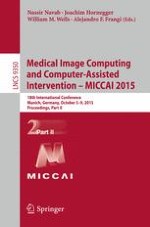The three-volume set LNCS 9349, 9350, and 9351 constitutes the refereed proceedings of the 18th International Conference on Medical Image Computing and Computer-Assisted Intervention, MICCAI 2015, held in Munich, Germany, in October 2015. Based on rigorous peer reviews, the program committee carefully selected 263 revised papers from 810 submissions for presentation in three volumes. The papers have been organized in the following topical sections: quantitative image analysis I: segmentation and measurement; computer-aided diagnosis: machine learning; computer-aided diagnosis: automation; quantitative image analysis II: classification, detection, features, and morphology; advanced MRI: diffusion, fMRI, DCE; quantitative image analysis III: motion, deformation, development and degeneration; quantitative image analysis IV: microscopy, fluorescence and histological imagery; registration: method and advanced applications; reconstruction, image formation, advanced acquisition - computational imaging; modelling and simulation for diagnosis and interventional planning; computer-assisted and image-guided interventions.
